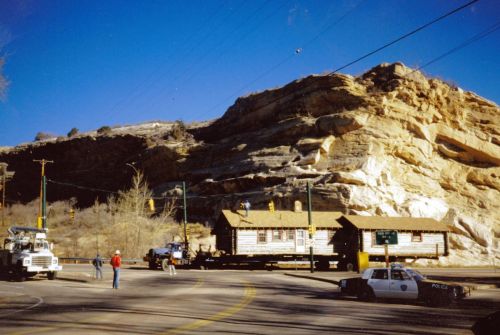See Part 1 of this story here.
We’ll pick up where we left off, with Town Manager Carol O’Dowd’s account of her meeting with Lee Cox:We reminisced about his life and how to save his home, now in the new state highway right-of-way. I offered the idea of using his cabin for a town museum. He liked the idea and approved. Lee died soon after he and his relatives gave the necessary signatures; he died comforted by knowing that his log home would live on as Morrison’s natural history museum….
Then came the challenge of moving the cabin. The Highway Department guys had a soft spot for Morrison and maybe for me—I had taken some pretty serious razzing from them in meetings where I was the only woman in a room with 20 engineer-type males. They gave us the cabin and 10 days to move it before the bulldozers arrived. Robin Smith helped me find a house-moving company just in time.”
Meanwhile, retired USGS paleobotanist and Town Board member Dick Scott had convinced the Town Board that a natural history museum, especially a free building complete with himself as free paleontologist-director, would be a great asset for Morrison. He writes:
“We picked out a site on Morrison’s 80-acre Designated Open Space at the south edge of town. The spot was next to the highway and on a hillside where a basement would double our space. Jack-of-all trades DeWayne Rhodig fired up the town backhoe.
The moving company slid long steel beams and wheels under the cabin. Early one Saturday morning a bulky procession led by our lone police car crawled down Morrison’s main street, lumbered around the left turn southward across Bear Creek, and inched its way into position above DeWayne’s excavation. Later, DeWayne constructed basement walls underneath. Lee Cox’s cabin then became the Morrison Natural History Museum…”
More from Dick Scott’s notes on Morrison’s late 20th-century history:
A few pages back we left the Cox cabin perched on steel beams over a hole in the hillside, awaiting conversion to be the Morrison Museum. Why start a museum? I had multiple reasons to believe in the project. First, Morrison’s unique role in the history of paleontology certainly justified a museum. Second, the museum’s visitors could bring needed dollars to our restaurants and shops. Third, the museum as an informal teaching tool could broaden children’s interest in science and nature through their strong fascination with dinosaurs. It was worth a try.
Arthur Lakes’s discovery of dinosaur bones north of Morrison in 1877 earned the small town a significant spot in history. Before the Morrison Museum formally opened, interest was arising in another kind of dinosaur fossils. When Alameda Parkway was extended over the Dakota hogback in 1937 by WPA workers, dinosaur tracks were uncovered along its route.
The east-side road cut through the steeply dipping Dakota sandstones, exposing large surfaces bearing ripple marks and literally hundreds of dinosaur tracks… Then reports surfaced about people digging up the tracks and stealing them. As the Morrison Museum began to take shape, Denver’s Metropolitan State University professor Dr. Martin Lockley, a dinosaur track expert, expressed concern about theft and destruction of these tracks. His concern led to the forming of the Friends of Dinosaur Ridge. The origins of the Morrison museum and the Friends were intertwined.
The early history of the Morrison Natural History Museum is tied to that of the Friends of Dinosaur Ridge, who aimed to protect the dinosaur tracks and educate the public about them. Dick Scott served as the first director of both entities, and the Friends initially met at the unfinished museum, which remained their headquarters until about 1993.







Pingback: Bead Hill Angus Ranch | Historic Morrison
Hi Sally,
I remember that, it was quite the cool project. It sure pretty around there now. Thanks for sharing * Have a safe and fun Winter; all, well stop and visit the Cox cabin next time I go through town. I use to get those Gents their coffee at the Dairy Treat in the Summer time. =
Cindy Jordan
Thanks for the comment, Cindy. We would like to hear more stories about the Cox family, if you want to share them. You can also email us at info (dot) morrisonhistory (at) gmail.com.
Pingback: Bead Hill Angus Ranch – Historic Morrison
I’m so grateful to you for Movig Mr. Cox’s. House. I’m not sure where the new location is, but Mr. Cox was a regular at my parents Texaco Gas Station in the 50’s Graham’s Texaco! Many a time did I go by Mr. Cox’s house on the way down the dirt road to visit school friends. Linda Nieman